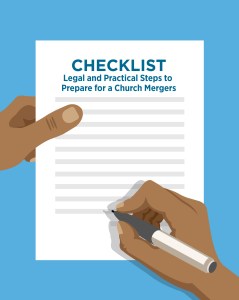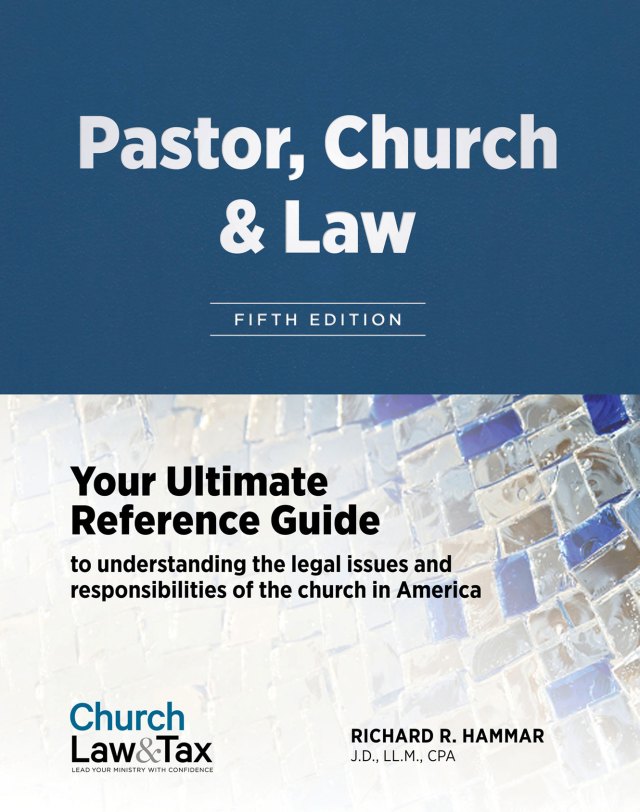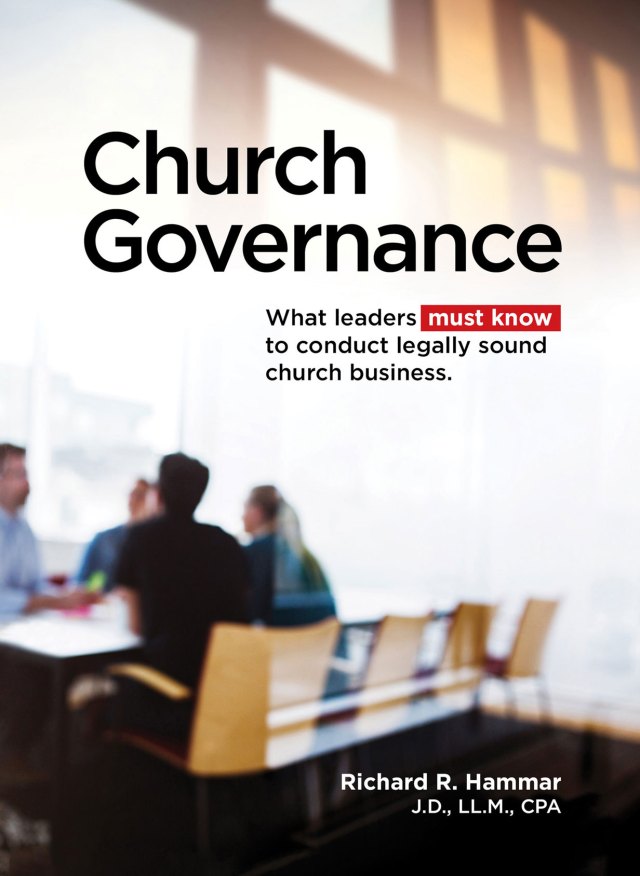A church merger involves a complex legal strategy. But the presence of complexity should not steer leaders away from it. Bill Gates, addressing the 2007 graduating class at Harvard University, noted complexity—not apathy—represents the true barrier to lasting change. “To turn caring into action, we need to see a problem, see a solution, and see the impact,” he said. “But the complexity blocks all three steps.”
Similarly, church leaders who care about the future of their church, and who see emerging challenges confronting it—whether an aging membership, shifting demographics in the surrounding community, diminishing revenues, and/or dilapidating facilities—may see a merger as a fruitful solution with potential long-term and lasting impact.
That means they must embrace the complexity that comes with a merger. Since the window of opportunity for a merger inevitably closes, embracing the complexity requires taking action. And taking action means the right leaders are making numerous key decisions.
Who makes the merger decision?
In an article “When Churches Merge” for Leadership Network, Jim Tomberlin and Warren Bird aptly state that “[m]ergers are complicated, and many issues must be addressed when undertaking one.” The authors go on to offer a number of questions leaders should ask about the decision-making involved. Here are some the most pertinent questions for the purpose of this article:
- How will the decision to merge be decided, and by whom? What do each church’s bylaws require? Will a congregational vote be required? If so, what will be the process and what percentage is required for approval? Even if not required, will a vote or poll be conducted as a way for the congregation to affirm their views? What is the lowest approval percentage the two churches are willing to accept?
- When is the earliest possible date a merger could occur between the two churches? What are the things that need to happen, and by when, for a merger to occur?
- In short, how can the merger be done legally, morally, and ethically?
The right decision-makers
It is critically important to ensure that the right persons or leaders are making the decisions. The ones responsible for decision making should be based on a church’s polity—its governance structure. Generally speaking, the power to make decisions takes one of three forms:
Who Makes the Decision to Merge?
The answer depends on the church’s governance model. Here’s how decision-making typically works across different structures:
1. Board-Led Churches
In this model, a governing board—often called the board of elders, trustees, or directors—is authorized to act on behalf of the congregation. The board must convene with a quorum to discuss and vote on the merger. While member approval may not be legally required, it’s often wise to involve them for several reasons:
- To foster unity and openness as congregations prepare to integrate.
- Because some states legally require member votes when disposing of property or if a church ceases to exist after the merger.
2. Congregational-Led Churches
Here, church members vote on most major decisions, including mergers, according to the bylaws. A proper vote requires:
- Advance notice of the meeting.
- A quorum.
- A congregational vote.
Some bylaws may also give the pastor a “super vote” or tie-breaking authority, especially since pastors often initiate merger discussions. If that’s the case, this role should be clearly explained to the congregation early in the process.
3. Denomination-Led Churches
In denominational structures, local churches are subject to decisions made by denominational leaders. These leaders often initiate and finalize merger decisions—especially when they observe patterns such as declining attendance, finances, or ministry activity in a local church’s annual reports.
In recent years, some denominations have begun merging entire districts, with district leaders in turn merging local congregations.
Caution: A common mistake is assuming that merging churches at the denominational headquarters level is sufficient. It’s not. Legal mergers must comply with local and federal laws, and failing to follow proper legal procedures can create significant issues.
Who Makes the Decision to Merge?
The answer depends on the church’s governance model. Here’s how decision-making typically works across different structures:
1. Board-Led Churches
In this model, a governing board—often called the board of elders, trustees, or directors—is authorized to act on behalf of the congregation. The board must convene with a quorum to discuss and vote on the merger. While member approval may not be legally required, it’s often wise to involve them for several reasons:
- To foster unity and openness as congregations prepare to integrate.
- Because some states legally require member votes when disposing of property or if a church ceases to exist after the merger.
2. Congregational-Led Churches
Here, church members vote on most major decisions, including mergers, according to the bylaws. A proper vote requires:
- Advance notice of the meeting.
- A quorum.
- A congregational vote.
Some bylaws may also give the pastor a “super vote” or tie-breaking authority, especially since pastors often initiate merger discussions. If that’s the case, this role should be clearly explained to the congregation early in the process.
3. Denomination-Led Churches
In denominational structures, local churches are subject to decisions made by denominational leaders. These leaders often initiate and finalize merger decisions—especially when they observe patterns such as declining attendance, finances, or ministry activity in a local church’s annual reports.
In recent years, some denominations have begun merging entire districts, with district leaders in turn merging local congregations.
Caution: A common mistake is assuming that merging churches at the denominational headquarters level is sufficient. It’s not. Legal mergers must comply with local and federal laws, and failing to follow proper legal procedures can create significant issues.
What Should Decision-Makers Consider?
Once it’s clear who has authority to decide, those leaders need to address some fundamental questions, starting with:
Is there alignment on vision, strategy, and culture?
These three elements—often called “the big three”—are essential to any successful church merger. While early discussions likely touched on these areas, final decisions must be rooted in clear alignment on:
- Vision (Where are we going?)
- Strategy (How will we get there?)
- Culture (How do we behave and relate to one another?)
Merging without shared clarity on these points sets the stage for conflict and confusion down the road.
What Should Decision-Makers Consider?
Once it’s clear who has authority to decide, those leaders need to address some fundamental questions, starting with:
Is there alignment on vision, strategy, and culture?
These three elements—often called “the big three”—are essential to any successful church merger. While early discussions likely touched on these areas, final decisions must be rooted in clear alignment on:
- Vision (Where are we going?)
- Strategy (How will we get there?)
- Culture (How do we behave and relate to one another?)
Merging without shared clarity on these points sets the stage for conflict and confusion down the road.
What will be the merged church’s name?
During due diligence, the churches must determine the name of the merged church. Options include continuing one church’s name, creating a new name that includes parts of both church names, or using a completely new name.
As a legal matter, confirm that the desired name is available for registration with the secretary of state before finalizing the selection of the name.
Your leaders should also review options for website addresses and other intellectual property considerations affecting the name chosen, such as whether there is already a filing with the United States Patent & Trademark Office (USPTO) that would prohibit the use of a logo, mark, or design associated with your chosen name.
The USPTO recommends that you check its site first to make sure someone hasn’t already registered a similar mark. You wouldn’t want to mistakenly infringe on another church’s mark or website address, or go through the trouble of deciding on a name only to find out it is not available in your jurisdiction.
Where will the merged church be located?
Again, based on the information learned during the due diligence stage, a decision should be made as to which location (or locations) will be maintained after the merger. Options include using space already owned or leased by one of the churches or selecting a place new to all merging churches.
Example 1
For example, one of the two merging churches owns a facility that can accommodate both congregations. The other church is renting a smaller space under a lease that is about to expire. It would likely be best for the merged church to come together at the larger, owned property. On the other hand, if the church with the smaller space still has many years left on its lease and a provision that prohibits the lease from being transferred, your legal counsel may advise you to delay the merger until the lease is closer to its expiration, or to try to negotiate an exit strategy with the landlord.
Relatedly, during the due diligence process, you should check to see if there are any personal guarantees under the lease or in any other contract. This information could be instructive when considering your options.
Example 2:
Consider this example: I recently represented a church that would be subsumed in the merger. The pastor of that church had personally guaranteed a lease that was worth more than $3 million over the life of the lease. Walking away from the lease would have severely harmed the pastor’s credit (not to mention his good name in the community), so that was not an option. Instead, we chose a strategy that would allow for the lease to be paid out over the obligated term while using the leased facility temporarily as an added campus for the merged church.
Another option that is increasingly useful is merging into one entity with multiple permanent sites. As referenced in the book Better Together, Making Church Mergers Work, it is estimated that “1 out of 3 multisite church campuses come as a result of a merger. Growing churches are utilizing mergers as a fast and effective way to go multisite.”
Also, the online campus has become an important addition to physical locations, catapulted by the reality of how COVID-19 required churches to adjust the definition of “meeting together.” Leaders consequently need to decide how their respective online presences—through a website, email communications, and social media—will come together.
Who will be on the pastoral staff?
“The most visible and delicate staff role to discuss in a merger transition is that of pastor,” say the authors of Better Together, Making Church Mergers Work. “What will happen to our pastor is also one of the first questions to address in the merger conversation.”
Because of the nature of the pastoral role and the many considerations unique to each congregation, there is not one answer to this important question; however, I will look at three possibilities.
Option 1:
The first option is to have the lead pastors of the merging churches serve as co-pastors. This would allow the existing pastors to retain top leadership roles and avoid the struggle of having to decide which of them will become lead pastor of the merged church. While this option provides a sense of “ease” by avoiding having to choose one lead pastor, it simultaneously creates a scenario that I rarely have seen succeed.
The challenges with having two lead pastors may include confusion among the staff as they try to figure out who to look to for needed direction; slowed or stalled projects while decisions get stuck at the senior leadership level; frustration among the leaders themselves, who are often used to a certain leadership style; and the optics through the congregational lens that look as though things are not settled at the senior leadership level.
Option 2:
Another option could surface if one of the pastors of the merging churches decides to use the merger as the opportunity to retire or otherwise minimize his involvement. This has the effect of making a clean line of the “before and after” merger scene, but it can add to the complicated feelings members may already have when a merger is announced.
Option 3:
The final and most common option I have seen is for the leadership of both churches to examine a matrix of considerations regarding the pastoral leaders—education, years of experience, size of church, effectiveness in church growth, connectedness in the community, and so on—with an ultimate decision on which of the merging church pastors will serve as lead pastor.
In my experience, honest discussions can lead one of the pastors to feel the call to shift away from the lead pastor role and into a new role. This new role may be something within the merged church (examples I have seen include outreach pastor, executive pastor, campus pastor at the location added by the merger, and pastor of global outreach). On the other hand, the shift could be to a new vocation completely outside the walls of the church (examples I have seen include college professor, entrepreneur, and writer).
In any event, as the saying goes, good fences make good neighbors. It is important for everyone to know what role each of the former lead pastors will take and for this to be communicated clearly with the congregations of each church when the merger is announced.
What other staffing changes will there be?
In a similar manner, the merging churches will need to determine what staff will continue and in what roles. If the merger does not create significant duplication of staff and finances allow for it, it may be best to keep staff for up to three years as the merged church takes root.
In considering staff, you should examine both employees as well as independent contractors. Since many churches have workers in both categories, it will be important to know this in order to get a complete picture of who is on payroll and what services they provide. And like the lead pastor role (and as it applies to specific roles), considerations might also be given to such factors as education, years of experience, size of church, effectiveness in church growth, and connectedness in the community.
How will ministries and ministry leaders change?
I have seen great success achieved when merging churches have complementary ministries. For example, one church is committed to international missions and the other church is committed to local outreach. In such instances, there may be only a limited duplication of efforts.
On the other hand, if the merging churches’ ministries are duplicative, the leaders must decide what ministries to continue and who will lead the new and continuing ministries. Most churches have a youth ministry, for example. If two churches merge and both have youth ministries, how will this ministry change and how will the youth leadership change?
In my experience, many churches strive to integrate both the leadership and the programs without eliminating anything (or anyone) for the immediate future, if budgets allow. Many times, however, the merger documents indicate that this integration is for a limited evaluation period (usually between 12 months and 36 months) at which point the situation will be reevaluated and additional changes made.
How will the new church be governed?
What governance style will the merged church follow and who will choose the governance style? As earlier referenced, the current governance documents are illustrative as to who will be on point for each church to make the merger decision. The same group of decision makers will be responsible to determine the governance style of the merged church. Once the decision is made regarding governance style, it may be necessary to update the church’s bylaws as the governance document. This is discussed further in Part 4 of this series.
In my experience, mergers that opt for board-led governance most often blend board members from each of the merging churches. Generally speaking, the smaller church (which is likely the church merging into the larger church) would take a smaller number of the board seats than the larger church. In any event, the blended board provides both churches with a proverbial seat at the table, which is critical for the ongoing building of trust.
Let’s consider one other possibility. What if a congregational-led church and a board-led church is considering a merger? This could be a very complicated situation fraught with many thorny issues. If a decision about which governance style to use in the merged church cannot not be reached, it could be a “deal breaker.” Further, trying to reach an agreement that does not respect each church’s governance style (as laid out in each church’s governing documents) could be difficult.
The key is transparency and good communication from the beginning so that the parties are aware of differing governance styles and mutually commit to doing the work necessary to harmonize those differences. This is a key area of variance that will need to be aligned before the merger gets finalized.
What are the steps for communicating the merger?
Key decision makers must decide how and when to share the merger news internally, locally, and beyond. On the front end, while the decision makers are still “kicking the tires,” so to speak, I have advised that communications regarding the possible merger remain confidential and shared only on an as-needed basis.
This commitment to confidentiality should be made in writing via a nondisclosure agreement (NDA). Such an agreement would allow the churches to negotiate in good faith regarding the potential merger while committing to keep in strict confidence the potential merger and any/all information received in the course of merger discussions.
While the initial NDA would be between key and pertinent leaders of the merging churches, your attorney may recommend that any staff members who will have access to merger information also sign an NDA. You would only want to involve staff in NDAs on an as-needed basis since the more people who sign NDAs, the more people who know of the potential merger. Staff members can sometimes feel concerned about whether a merger may result in job loss and may have less motivation for keeping information confidential if they leave the employ of the church.
Caution. Don’t attempt to create an NDA without guidance from qualified legal counsel.
When the merger decision has been made, it is important to share this information in a positive and measured way. Of course, it is most important that the membership of the merging congregations be the first to know, and a detailed communications strategy be developed from there. Commonly, the merger of larger churches may require a more detailed and expansive communications strategy.
How will congregants mourn and say goodbye?
It is important to end one thing well before moving to the next. While it is exciting to begin plans for the newly merged church, it is critical to also plan how members can say goodbye to their respective churches, including the ministries that are either changing or dissolving, as well as people whose roles are changing or phasing out with the merger.
Many see a proper ending as the precursor to a good new beginning. Giving voice to the fact that the merger may be hard on some—as they leave behind the history of something as personal as one’s church—can provide the needed catharsis.
What will honoring the merging church look like?
Decide how to honor the church formed through the merger. Perhaps the respective churches provide a beloved ritual or item. Perhaps some type of ceremony commemorating the union is also hosted. I have also seen beautiful video presentations that honor the history, leaders, and staff of the merging churches. Regardless of what gets pursued, make certain to honor the newly formed congregation and establish new shared traditions and culture.
Note. Each of the above decision areas are listed on the downloadable checklist.
Making the right decisions by the right people
Leaders should be keenly aware of what merger decisions need to be made and who has the legal authority to make such decisions. And by thinking through and following through on the above questions, these key decision makers should be ready to take the specific actions steps.
Also in this series:




